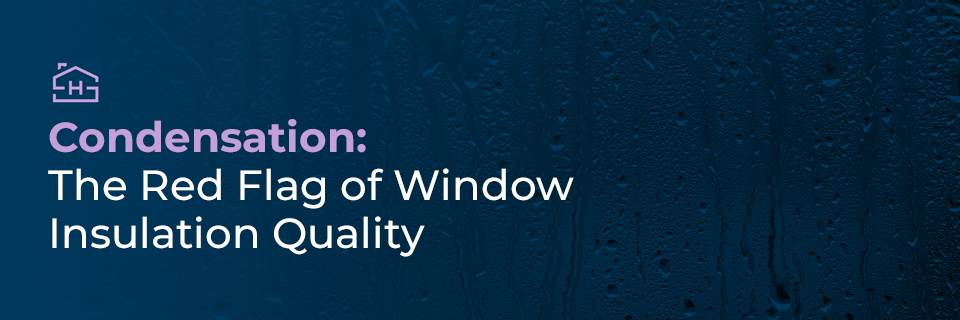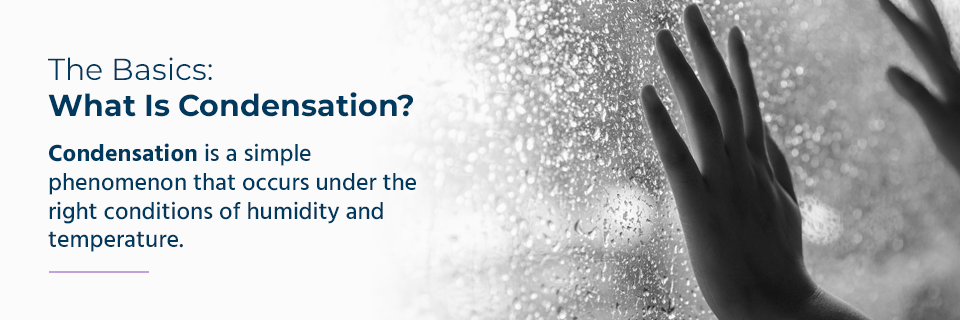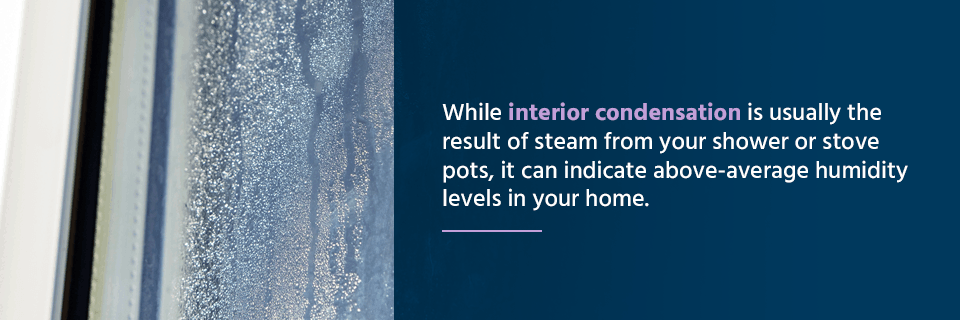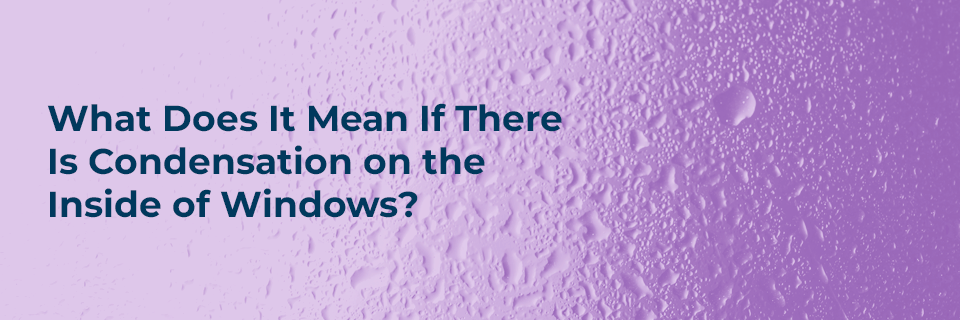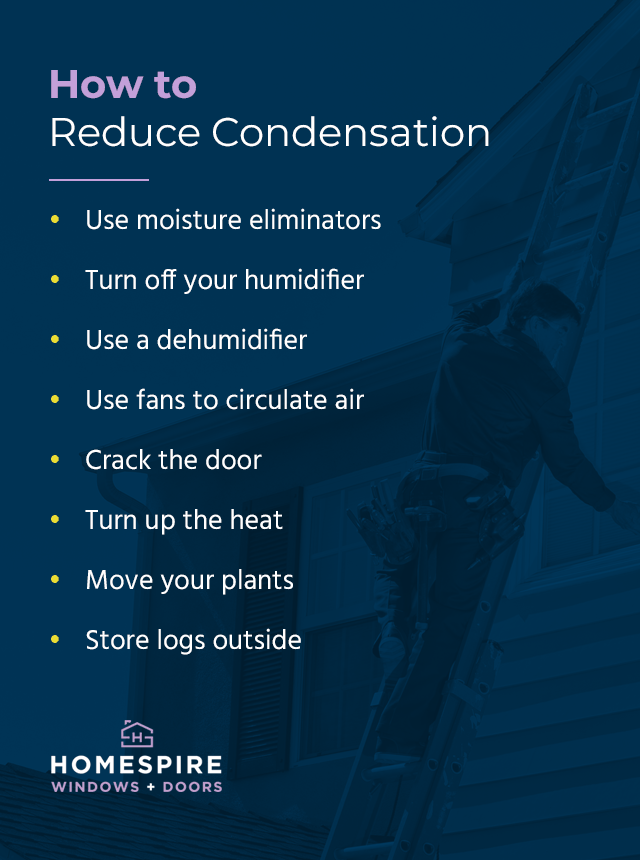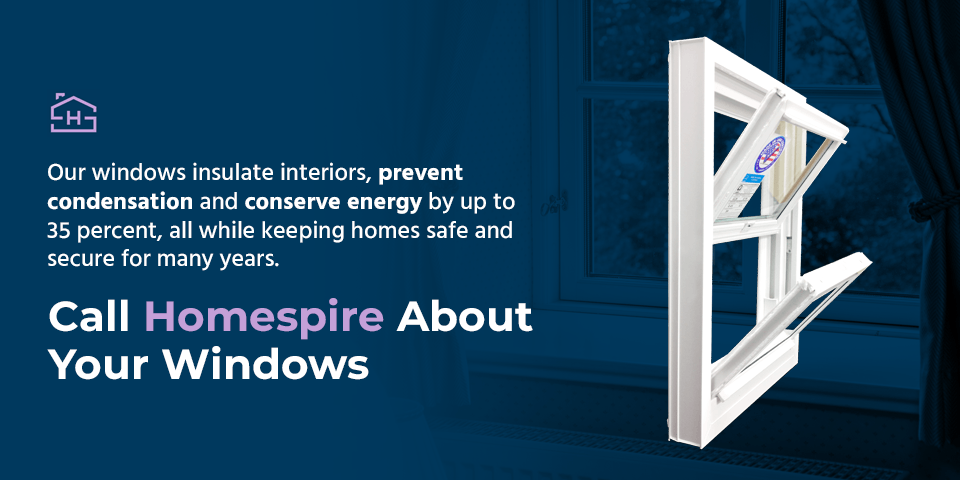Jump to:
- What is Window Condensation?
- Condensation on the Outside of Windows
- Condensation on the Inside of Windows
- What Does It Mean If There Is Condensation on the Inside of Windows?
- Condensation In Between My Window Panes
- How to Reduce Window Condensation
Steam is one of the more annoying side effects of winter weather. When your windshield takes 10 minutes to defog, steam can be an impediment. Steam can even stall your momentum as you scramble to get ready in the morning, such as when you emerge from a hot shower and the bathroom mirror is covered in fog.
That fog is called condensation. It’s an afterthought during your morning routine, but not something to overlook in other aspects.
In an enclosed setting, steam exacerbates condensation. As such, the steam from your shower that fogs up your bathroom mirror can also spread throughout your house. Even when you maintain a warm indoor temperature, your window panes will generally be the coldest surfaces in any given room because the glass will have direct contact with the outside air. Unlike walls, which have inner and outer panels separated by insulation-filled cavities, window panes are the most vulnerable feature when it comes to outdoor temperatures.
Under certain circumstances, condensation on windows can indicate their quality.
The Basics: What Is Window Condensation?
Window condensation is a simple phenomenon that occurs under the right conditions of humidity and temperature.
When an object is cooler than the air around it, the water molecules in the air come together and “stick” to the surface, forming a thin layer of water droplets. It happens on your glass of cold lemonade during hot weather and on the windows of your car and even the windows of your home during colder weather.
Condensation on Windows
In most instances, you can see condensation inside closed environments on days when the outside air is cold. Condensation will often occur during fall and winter months when steam is released into the air. Whenever you take a shower or cook a bowl of pasta, and the windows become steamy, those are classic examples of interior condensation.
Windows are among the most prevalent spots within a house for condensation because window panes are generally the coldest surface within an interior space. Due to its direct contact with the outside coldness on a fall or winter day, the inside surfaces of glass panes are often as cold as the air outside. Glass panes are the most noticeable place where condensation occurs, but you can also find moisture on window frames and fixtures.
The appearance of condensation on windows can be a mixed blessing in that it will generally indicate strong insulation. Whereas older, weaker windows may allow moisture to escape your house, a new and tighter set of windows will generally trap that moisture.
Is condensation a cause for alarm? It depends on where it accumulates.
The Good: Condensation on the Outside of Windows
For anyone who purchases a new set of windows, the appearance of outside condensation can be surprising. However, external condensation is a good thing.
Outside condensation results from unusual conditions when the air outside is slightly humid and warmer than the temperature of your window glass. This can occur when the weather is neither warm nor cold.
Outside condensation means your windows are not allowing any heat transfer. So if you have some fog on the outside of your windows, you can relax. Your windows are just doing a good job of insulating your home.
If the windows are at street level, you can wipe away the condensation from the outside. However, the best option is to simply wait, as the condensation will usually disappear when the sun points directly at your windows.
Keep in mind that it’s still a good idea to check your sills and frames. If you have gaps between the window and frame, you may find patches of condensation collecting inside your home, which could indicate moisture inside your walls. It’s important to check for drafts around your windows to protect your walls from water damage.
The Bad: Condensation on Inside of Windows
If condensation forms on the inside of your windows pay close attention. While interior condensation is usually the result of steam from your shower or stove pots, it can indicate above-average humidity levels in your home. You may have a ventilation problem.
Excess moisture and collecting water around the house can be very damaging to your home and to your family’s health.
If your home is not being properly ventilated, moisture from your body, your water system, and even cooking can collect in the air over time. If the water vapor has nowhere else to go, it condenses on windows, as well as on furniture, in carpets, and inside walls.
This creates two huge problems.
First, the moisture makes a perfect breeding ground for mold and mildew. Mold and mildew typically appear on the walls around or below your windows and look like tiny black spots or a gray cloud due to the humidity levels in your home and interior window condensation. Your drywall isn’t the only place the mold or mildew can congregate. Homeowners can find mold on any items made of wood, carpet, insulation, paper, or food because of window condensation and humidity inside of your home. Mold is damaging to your home and has an impact on your health.
Exposure to mold can cause various health issues depending on the person and their mold sensitivity. Many people are unaware they have mold and mildew allergies until they experience an allergic reaction. Because the symptoms are almost identical to asthma and hay fever, most who suffer are misdiagnosed. Other signs of mold exposure include coughing, nasal stuffiness, eye irritation, throat irritation, and possible skin irritation. It is likely at least one of your family members is allergic, which means year-round reactions until the allergen is gone.
Second, since the moisture can’t escape, it can cause deterioration of the home. Wood that absorbs water tends to soften, develop mold or even rot. When water dries on a metal surface, rust is likely to form. The effects of condensation can gradually compromise the structural integrity of your home and open gaps in the process, which could ultimately weaken the insulation of your interior quarters. Over time, this can cause thousands of dollars in damage.
The most beneficial action you can take to reducing the amount of mold or mildew in your home is to prevent window condensation in your home and control humidity levels. You’ll support you and your family’s health by learning ways to combat window condensation while also keeping your home safe and energy-efficient.
What Does It Mean If There Is Condensation on the Inside of Windows?
High humidity isn’t the only reason for interior condensation. If the problem is only occurring on select windows, it’s possible you have a draft problem. If there is moist air coming into the house around a particular window, that moisture will collect on that window pane first. If this is your case, you’ll need to check for air leaks around the window and call a professional to reseal or replace it, depending on the severity of the gap.
Moisture on the inside of windows could be a more serious problem if the condensation stems from an unknown cause. If you are careful about steam and use fans, doors and barriers while showering and cooking, yet the glass interiors still get fogged, there could be undetected sources of moisture within your living quarters.
Fire logs, for example, are often moisture-ridden, especially if you store them outside or in your garage before stacking them next to the fireplace. Houseplants can also be a source of condensation, as the water they release into the air is sometimes dispersed to cold surfaces during fall and winter months.
Condensation inside your windows is bad. But unfortunately, it can be worse.
The Ugly: Condensation in Between My Window Panes
Your worst-case scenario is condensation between the panes of your window.
In cases like these, the situation might seem hopeless. After all, how can you get between the two panes of glass? Sometimes the problem can be remedied. Often, however, the fog will indicate a more serious problem that can only be solved with a new set of windows.
Most windows are double-or triple-paned. What does that mean? When you look at the glass of a window, you are actually looking at two or three pieces of glass layered and held together by a single frame. These pieces of glass are called panes.
Double-and triple-paned windows are made to insulate your home. The frame of the window holds the panes in place and leaves space between each one. This space is filled with an insulating gas like argon and then is sealed air-tight.
Double-paned windows have grown in popularity because of their superior insulating qualities. Homespire Windows go even further with a 12-layer system of protection to keep your home efficient and secure.
The appearance of condensation between a double-pane of glass indicates that the windows are not doing their job properly. The air-tight seal holding the insulating gas inside has failed, letting all the insulating gas out. When this occurs, water vapor could get between the two panes if the temperature of the glass drops below the dew point of the surrounding air.
You are now collecting moisture, which can lead to further damage to the window, and wasting drastic amounts of energy to heat and cool your home. Without the insulating gas, your windows are letting heat in during the summer and out during the winter.
If you have condensation between your panes, you definitely need new windows. Replace your windows with quality, energy-efficient windows from Homespire that are backed by a Signature Warranty, so you’ll never have to worry about your windows again for as long as you own your home.
How to Reduce Window Condensation
The presence of condensation on the inside of house windows can generally be eliminated with one or more of the following measures:
- Use moisture eliminators: To reduce the amount of moisture that travels through your interior air, place desiccant bags next to your windows and mirrors. If placed in your drawers and closet, desiccants can also protect your clothing from moisture.
- Buy a dehumidifier: If condensation has been especially thick and common during winter months, consider investing in a dehumidifier. Most units sell for about the same price as an air conditioner but can be just as essential to the comfort of your living quarters.
- Turn off your humidifier: If humidifiers are a feature of your living environment, consider deactivating them on cold days when your windows are condensation-prone. The mist released into the air can fog up your windows on cold days.
- Use your fans: Each time you cook or take hot baths or showers, turn on the corresponding fans for such activities. The fan in your bathroom can help minimize condensation on the mirror and prevent the spread of steam, thus eliminating fog buildup on your windows. Also keep the bathroom door closed whenever you shower.
- Circulate your rooms: Warm air travels upward within an enclosed space. Run your ceiling fans clockwise during the colder months to circulate the warmer air downward.
- Crack the door: If the outside temperatures are not too cold, crack your front or back door for a few minutes to release steamy indoor air.
- Turn up the heat: If the air within your living areas is raised to spring temperatures, you could reduce the possibility of condensation on your inner panes, especially if the heat source is located near your windows.
- Move your plants: Any plant within your house is a source of air-bound vapor. If you normally place plants along your window ledges, relocate them to other areas within your living quarters during colder months. Refrain from over-watering your plants, as doing so will intensify the vapor content of the air in your rooms.
- Store logs outside: Logs will usually have significant water content from the time they have spent outside before use. If you bring them inside weeks in advance of their ultimate use, the vapor content in your interior air could thicken as a result.
- Switch to double-paned windows: Despite being a common feature in homes built within the last 15 years, double-paned windows are rare in older homes. If you have not done so, consider switching from single- to double-paned windows. If and when condensation between window panes does appear, the problem can usually be solved by replacing one of the glass panes.
Call Homespire About Your Windows
Investing in new windows is a unique opportunity to improve the energy efficiency, security and curb appeal of your home, all at once. It’s rare that one purchase can do so much for your home and your family.
Homespire Windows and Doors offers windows that deliver on all three fronts. You can choose from multiple color options for both the inside and outside frame of your windows to fit your home’s style. Our ability to custom design your windows allows for perfectly fitting windows, eliminating drafts and offering creative solutions for out-of-the-ordinary spaces. Finally, we incorporate technological advancements to create the most structurally sound window on the market. And you can rest assured your investment with Homespire will be your last, with all your windows guaranteed under a Signature Warranty.
At Homespire Windows and Doors, we sell and install energy-efficient windows consisting of a 12-layer glass system. These windows insulate interiors, prevent condensation and conserve energy by up to 35 percent, all while keeping homes safe and secure for many years. For more information on how Homespire windows can transform your home, contact our service representatives today.
Remember, if your window condensation is looking ugly, invest in the best with Homespire Windows.
Get 20% Off
PLUS
No Deposit, No Payments, and No Interest for 12 Months*
*By completing the form, I consent to have Homespire Windows and its affiliates contact me to verify my information, schedule an appointment, or inform me of future product updates, which may include marketing. I consent to receive calls or texts that use automated technology or a pre-recorded voice at the phone number(s) provided. Consent is not required to receive goods and services. I can call the phone number found at the top of this web page. Please see our Terms & Conditions. Msg & data rates may apply.
